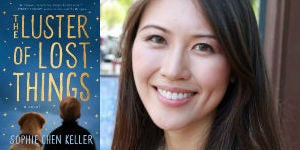What Debut Novelist Sophie Chen Keller Found
August 7, 2017
 At the heart of THE LUSTER OF LOST THINGS , the first novel by Putnam author Sophie Chen Keller, is Walter Lavender, Jr., silenced by a motor speech disorder but a master of finding, a son keeping vigil, twelve years and counting, for his lost father. When the book at the root of magic served up at the family bakery, The Lavenders, vanishes, Walter, accompanied by his overweight golden retriever, journeys through New York City to find it—along the way encountering an unforgettable cast of lost souls.
At the heart of THE LUSTER OF LOST THINGS , the first novel by Putnam author Sophie Chen Keller, is Walter Lavender, Jr., silenced by a motor speech disorder but a master of finding, a son keeping vigil, twelve years and counting, for his lost father. When the book at the root of magic served up at the family bakery, The Lavenders, vanishes, Walter, accompanied by his overweight golden retriever, journeys through New York City to find it—along the way encountering an unforgettable cast of lost souls. 
Popular Company News
Former First Lady Michelle Obama to Publish THE LOOK With Crown Publishing Group
June 5, 2025
The Crown Publishing Group today announced THE LOOK, a new book from Michelle Obama, former First Lady of the United States, to be published November 4, 2025.…
PRH Acquires Wonderbly, One of the UK’s Fastest-Growing Independent Publishers and Leader in Personalized Gift Books
June 4, 2025
Acquisition Underscores Penguin Random House’s Commitment to Innovation and Growth Penguin Random House, a leading global trade book publisher, has acquired Wonderbly, one of the UK’s…
Matthew McConaughey, Academy Award-Winning Actor and Author of GREENLIGHTS, to Publish New Book With Crown
June 26, 2025
Crown, an imprint of the Crown Publishing Group, announced the September 16 publication of POEMS & PRAYERS by Matthew McConaughey, an eternal optimist, Academy Award–winning actor,…
Legendary Thriller Author Frederick Forsyth Passes Away at 86
June 10, 2025
Frederick Forsyth, bestselling author, British RAF pilot, and journalist died on Monday, June 9, 2025. He wrote eighteen espionage thrillers including THE DAY OF THE JACKAL, THE…
Penguin Young Readers to Publish Debut Picture Book by Jalen Hurts, Philadelphia Eagles Quarterback and Super Bowl MVP
June 24, 2025
Jalen Hurts, Philadelphia Eagles quarterback and 2025 Super Bowl MVP, will publish his debut children’s picture book with Flamingo Books, an imprint of Penguin Young Readers…
PYR to Publish New Book for Tweens Inspired by the #1 NYT Bestseller, THE ANXIOUS GENERATION
May 21, 2025
Rocky Pond Books, an imprint of Penguin Young Readers, will publish a companion to social psychologist Jonathan Haidt’s #1 New York Times bestselling and culturally transformative…
Tiny Reparations Books Celebrates Their 5th Anniversary and Publication of Tourmaline’s MARSHA
June 4, 2025
On May 22, Tiny Reparations Books celebrated two momentous occasions: the 5th anniversary of the imprint and the launch of the National bestseller MARSHA, Tourmaline’s highly anticipated biography…
Penguin Press and Penguin Random House Social Impact Team Partner to Donate THE JAILHOUSE LAWYER to Incarcerated Individuals
June 25, 2025
On July 8, Penguin Press will publish THE JAILHOUSE LAWYER by Calvin Duncan and Sophie Cull. This title is a searing and ultimately hopeful account of…
Companhia das Letras Recognized in Folha De S. Paulo’s Best Brazilian Books of the 21st Century
June 9, 2025
Folha de S. Paulo, a renowned Brazilian daily newspaper founded in 1921, recently released an issue celebrating the most noteworthy Brazilian literature of the 21st century. …
